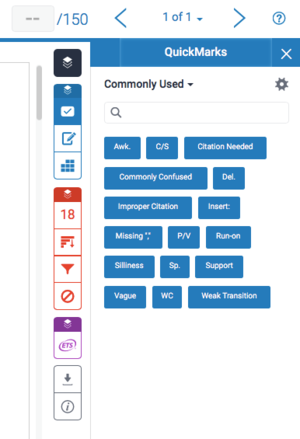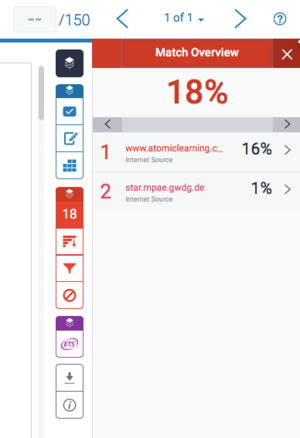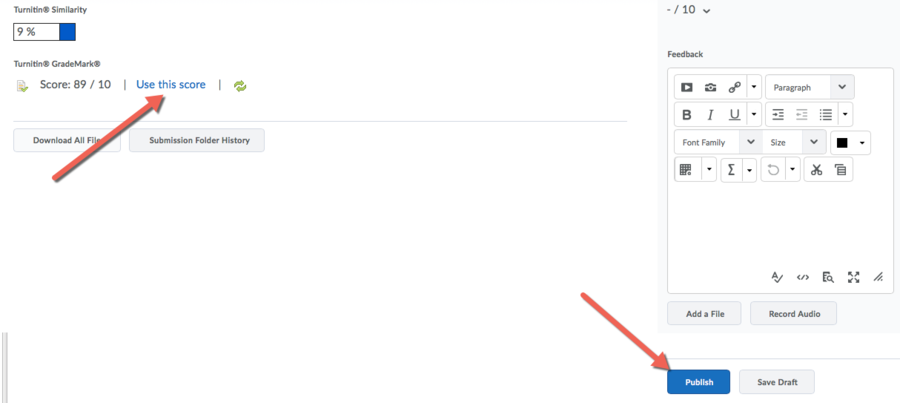Draft:Using Turnitin to assess student writing
Intended Audience
WSU instructors currently using Brightspace and interested in assessing writing quality and originality using Turnitin.
Assessing student writing with Turnitin
Submitting student work for scanning
When you view the submissions in an Assignments folder that is configured to use Turnitin, there will be a column directly after the submission names entitled Turnitin Similarity. This column reflects the outcome of the scan and serves as the jump-off point to enter Turnitin Feedback Studio to complete the assessment. There will be one of three graphics displayed after each file submitted to the folder:
|
|
The student submission has not yet been sent to Turnitin for scanning. If you have configured Turnitin to automatically submit for scanning, the file will submit soon. Otherwise, you can clicking on this icon to submit the file immediately. | |
|
|
The student work has been sent for scanning. | |
|
|
The scan is complete and the number reflects the originality score. The lower the number, the more original the submission. Click on this box to enter Turnitin to view the results, add your own feedback, and assign a grade to the work. |
Assessing the submission
The overall controls
To enter Turnitin Feedback Studio, click on the similarity score box after the file name in the submissions table. You will see the submission with a series of marks and comments inserted by Turnitin. You will also see a set of controls in the top right corner of the window that allow you to investigate Turnitin's comments and add your own feedback.
- At the top of the controls is the spot in which you ultimately enter the grade for the assignment.
- Next to the score is a recap of how many submissions are available for viewing. Click the large left arrow to move to the previous submission and the large right arrow to move to the next.
- There are controls for the feedback layers below document count and navigation arrows. The purpose of each layer is described below.
The QuickMarks layer
The QuickMarks layer recaps issues like awkward word usage, citation issues, vague wording, and other common problems. The controls for this layer are located near the top of the toolbar and are shown in blue.
There are three icons in the QuickMarks controls:
- The box-with-the-checkmark icon shows the tags Turnitin uses to flag problems in the document. (The image at right shows this view.) You adjust the feedback for the tags or add new tags of your own by clicking the gear icon at the top right of the controls.
- The pencil-and-paper icon opens an area where you can type in comments or create audio feedback.
- The waffle-with-a-missing-square icon is where you create and use rubrics. These are separate from the icons you created in Brightspace.
The Originality layer
The Originality layer shows the results of the Turnitin originality scan. The controls are located in the center of the toolbar. They are red.
The buttons, from top to bottom, display the following:
- The button with the number represents the percentage of the paper that was found in other sources within Turnitin's data collection. (This is the view that is displayed in the image at right.) The list shows the sources of the potential plagiarism. Clicking the arrow after each source will display a detailed list of the possible problem areas. Clicking the items in the detailed list shows the location within the student submission as well as a clip from the document found by Turnitin showing the conflicted text.
- The bar-graph icon displays a sorted list of the sources found by Turnitin. Clicking items in this list displays the found source overlaying the student document.
- The funnel icon lets you ignore things like quotes and bibliographic entries.
- The circle-with-the-slash lists the source documents that were excluded from the scan.
Spelling, grammar, mechanics, style, and usage
Spelling, grammar, mechanics, style, and usage are scored and flagged by Feedback Studio and the e-rater. The controls for the e-rater are at the bottom of the toolbar and are purple in color.
- Each occurrence of an issue is flagged in the submission with a tag. The tag contains an abbreviation the tells the type of issue found.
- Under the controls at the right is a recap of all the common problems Turnitin looked for in the document and how many of each problem was found.
The final two buttons under the e-rater controls allow you to:
- Download a copy of the submission. You can download the submission in one of three ways:
- Current View that includes all mark-ups and comments. This is a PDF.
- Digital Receipt showing information about the submission and when it was submitted. This is a PDF.
- Originally Submitted File that is a copy of exactly what was submitted by the student.
- Look at information about the file itself, such as submission date, file size, and information about the Turnitin scan.
Publishing the Turnitin score to the Grades tool
- Go to View submissions in the desired Assignments folder
- Select Evaluate after the student's name
Tips
- If you wish to use Turnitin and a rubric, create the rubric in Turnitin, not Brightspace. Rubrics created in Brightspace are not available in Turnitin.
More Information
There is a full overview of using Turnitin in Brightspace at Turnitin for instructors.
There is more information on how to configure Assignment folders to use Turnitin at Enabling Turnitin tools in your Brightspace assignment folders.
Related Wiki TopicsNo pages meet these criteria. |
D2L Overview Topics |
For a complete listing of topics, select from the category list below.




